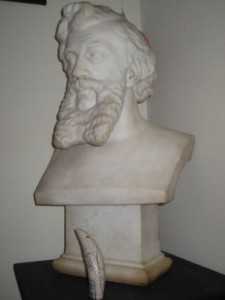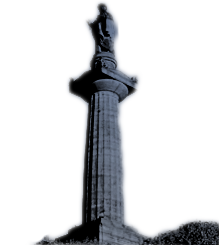Original inscription: “In Memory of Andrew Harper, Merchant, Glasgow. Born at Kilmarnock, 16 May 1807. Died at Langbank, 29 Nov 1883. Also of Five children, who died under eight years of age.”
Added later, after 1895, “Jean Hill, his wife. Died at Langbank, 19 Augt 1895, in her 88th year”
On base: “The Lord is my shepherd, I shall not want”
(The memorial is one of a number of works of Peter Smith, himself buried further up the hill)
Andrew Harper, a provision merchant of Glasgow, was born at Holm Head, Kilmarnock on 16th May 1807, the second son, and one of ten children, of Andrew Harper (sen.) ( 1773-?1846), weaver, and Agnes Fleming (6th May 1781-?1847).
There were three other children of the first marriage of Andrew Harper (sen.): John, 1 Sept 1798, Sarah, 2nd June 1800, and John, 4th May 1802 – the last two, at least, born at Holm Head. Little is known of them.
In his second marriage, to Agnes Fleming:-
Andrew’s older brother John, was born on 11th October 1805, but nothing further is known about him. His younger sibs were:-
Robert (also born at Holm Head, Kilmarnock), 30th December 1808
Daughter to Andrew Harper, weaver, Holm Head (no name listed in the parish register) on 7th November 1810
James, to Andrew Harper, grocer, Bank Street, Kilmarnock, 1st May 1812
Agnes, to Andrew, merchant, Laigh Kirk and Agnes Harper, at Kilmarnock, 18th April 1814
Thomas, at Kilmarnock, 3rd January 1816
Elizabeth, to Andrew Harper, grocer, Strand Foot, 18th July 1818
Twins, Mary Anne and Jean (Jane?), at Kilmarnock, 26th December 1829
In his early life he was a grocer’s assistant in Paisley, but moved to the centre of Glasgow and built up a successful business as a victualler and provision merchant, eventually in the wholesale as well as the retail trade, before retiring to Langbank in Renfrewshire. He died there on 29th November 1883, aged 76 years, and was buried in the Glasgow Necropolis.
His father, also named Andrew, was initially a weaver; his forbears were weavers and garment makers, from the Kilmarnock-Kilmaurs and Stewarton area. His father was married at Kilmarnock to Agnes Fleming, on 26th December 1804, his second, and her first, marriage. It may be supposed that he foresaw declining prospects for those occupations, for he became a grocer in Bank Street, Kilmarnock, by 1812, (Indeed, it is said that the ‘Radical Road’ on Arthur’s Seat in Edinburgh was a ‘job creation scheme’ for unemployed weavers, in the 1820s). In 1814 Andrew Harper (senior) was recorded as a ‘merchant, Laigh Kirk’; in 1818 he was a grocer at ‘Strand Foot’, and 1820 at ‘Step Foot’, Kilmarnock (all these addresses given in the Kilmarnock Midwives’ Register on the occasion of the births of three of his last five children}. He was still living in Bank Street, Kilmarnock at the time of the 1841 census, with his wife and youngest 20-year old daughter, (a twin, Jean – whose married name is thought to have been Mrs Blair).
Andrew Harper (senior) finally moved to Glasgow in 1842, following the example of his sons, Andrew and Robert, who had already moved to the city about five years earlier, and were expanding similar successful businesses. He was listed as a grocer in Glasgow at 121 Saltmarket Street from 1842-3, and in Crown Street from 1843 until 1847-48, his last definite appearance in the records, suggesting a possible date of death about 1847, when he would have been 73 years of age. (A death of an Andrew Harper is recorded on 20th December, 1848, in Stewarton parish, but it is thought to be unlikely that this is the same person). It is not certain where, and exactly when, Andrew Harper (senior) died.
Andrew Harper, (junior) whose memorial now stands in the Necropolis (see photograph), was born on 16th May 1807, the second son of Andrew Harper (senior) and his second wife Agnes Fleming.
He spent his childhood in Kilmarnock, and the first record of his adult life (letters in the family’s possession) show that he was working in Paisley in 1832, at Messrs Hamilton & Wilson, victuallers, 17 Moss Street, Paisley, at the age of 25.
He was still a grocer there, two years later, when banns were called in Paisley Middle Church Parish, (OPR 573/2) prior to his marriage at the age of 27, on 27th July 1834, to Jean (Jane) Hill, residing in Abbey Street, in the same parish. They seem to have been married however, in Paisley Abbey parish (OPR 559/8). The service was conducted by a well-known preacher, Rev. Alexander Fleming, D.D., of Neilston, who was Andrew Harper’s great-uncle, then aged 74.
Andrew Harper’s first two children were born in Paisley: Jane (21st April 1835) and Agnes (9th February 1837). Pigot’s 1837 Directory lists an Andrew Harper as a victualler at 1 Old Sneddon Street, Paisley. He moved to Glasgow in 1837 or 1838, where the remainder of his family were born. He began by going into partnership with his younger brother Robert as A. & R. Harper, victuallers, at 106 Main Street, Gorbals, but the partners soon each set up their own businesses.
His brother Robert remained working at that address until 1848, while his home was at 167, and later 194 Main Street, Gorbals. He opened other shops at 51 Burnside place (Garscube road) from 1840-1842, and at 37 Malta Street (later Norfolk Street), 38 Cavendish Street, and 71 King Street, Tradeston, for short periods, in tandem with his principal base in Main Street, Gorbals. Finally Robert moved house in 1851 to 152 Buccleugh Street, with premises at 34 St George’s road, then 12 Bank Street, Hillhead, where he is last recorded in 1853-54. He finally emigrated with his family to Australia in August 1856, where he prospered, setting up the firm of Robert Harper & Co., Melbourne, trading in tea, coffee and spices from the East Indies, and later in oatmeal and flour. Robert died in Australia on 9th January 1919.
Andrew Harper himself spent his first year or so in Glasgow from 1837 in partnership with his younger brother, but soon set up on his own for the next twenty years in the Gallowgate (284, then 290 or 292). He is described variously as a victualler, or provision merchant, but also as a baker for some years in the 1840s, when he owned several subsidiary retail shops, at 2 Kirk Street, Townhead; 92 Kirk Street, Calton; 152 (or 159) Castle Street, Townhead; and Blue vale, Duke Street. He then acquired a wholesale provision store at 72 Broomielaw Street in 1848. In 1851 he moved his store to 11 Stirling Street, and in 1861 to Blackfriars’ Street (41,45, or 47), for the remainder of his working life. He was last described as a provision merchant in 1870-71.
He and his family lived initially at 37 Graeme Street, until 1859, when they moved to 136 Stirling Road (initially also known as Sackville Place), where their three daughters were all married (in 1860, 1867 and 1870). The 1871 census showed he was still at 136 Stirling Road, (at the east end of Cathedral Street, opposite the Royal Infirmary), with his 84-year-old mother-in-law Jean Hill (his wife was staying with their married daughter in Keith on census day). But by 1872 he was no longer at this house; he had bought some land, for he is now described as a ‘portioner’, (or ‘proprietor of a piece of land once part of a larger estate’), and was staying with relatives for the two or three years. By 1875 he had moved to Rosebank Villa, Langbank, Renfrewshire, and resided there for the rest of his life. His mother-in-law died there on 19th October 1875, aged 89. A note is added in the Glasgow Post Office Directory for 1875-76: “letters to be left with D. Riddell (his son-in-law’s), 16 Hope Street He died there on 29th November 1883, aged 76 years. His widow, Jean Harper, continued to live there until she died, aged 87, on 19th August 1895. Both were interred in his lair at Glasgow Necropolis, where five of his eight children had already been buried many years earlier.
The five young children also interred in this lair (between 1843 and 1856) include Agnes Harper, 6 years (b. 9/2/1837, buried 6/6/1843); Agnes Fleming (Harper), 5 years (b. 5/2/1845, buried 13/12/1850); John Long (Harper), 1yr 5 mths (b.8/2/1851, buried 19/7/1852); and Andrew Harper, 7 years (b. 9/3/1849, died 17th, buried 19/3/1856). The fifth child, not recorded in the burial records, could have been his first child, Jane (b. 21/4/1835). .
Only three daughters, (the third, fourth and fifth of his eight children), survived into adult life:-
Mary Ann, born on 23rd May 1839, married David Stirrat on 21st June 1860, in the family home at 136 Sackville Place, Stirling Road, Glasgow, and soon after emigrated to Queensland, Australia, where they developed a ‘station’ at Mount Alma, near Calliope, about 20 miles from the coast. She died there on 22nd June 1889, aged 50.
Janet (or Jessie) was born on 17th June 1841, and married the Rev. William Gillespie on 12th May 1870; she died at Bearsden, Glasgow, on 28th March 1938, aged 96.
Jean Smith Harper (or Janie), the writer’s great-grandmother, was born on 4th May 1843, and married a neighbouring grain merchant, David Riddell of 446 Gallowgate, on 14th November 1867; she died at Rutherglen on 10th April 1916, aged 72.
It must have been a great sadness that his only two sons who might have succeeded him, Andrew and John, were two of these eight children buried here. But there was nevertheless a continuing family connection to the grocery trade, with John Riddell’s grain merchant business in the Gallowgate, and whose son David, Andrew’s son-in-law, was entering the trade.
It might be of interest to note that a photograph handed down through the family showed its original state, with a shorter inscription, (between 1883 and 1895); the writer searched for it in 1995, and again in 2002, finding it lying toppled, upside down, separated from its pedestal, and on the uphill side of a grassy terrace, two levels below its expected position; it was noted that his wife’s name had been added since the first photograph was taken. In 2013, during a guided tour of the newly refurbished Necropolis, it was noticed by his great-great-grandson, repaired and restored, upright, and most likely replaced in or near to its original position, on the downhill side of the access pathway leading left from the bridge, looking towards the Cathedral and Royal Infirmary.
With acknowledgements to: the restorers of Glasgow Necropolis; family history research by the late Andrew Harper Dinwoodie (great-great-grandson); with additional material from the Glasgow Post Office Directories held on the National Library of Scotland website. Hugh Parker Dinwoodie (g.g.grandson), Nov. 2013




















